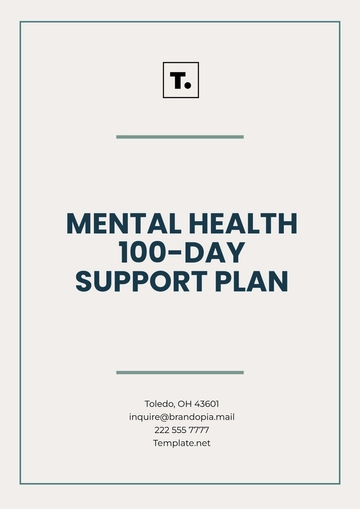Free Employee 100-Day Improvement Plan

Employee Name: Jean Harris
Role/Position: Marketing Coordinator
Department: Marketing
Manager: [YOUR NAME]
Date Started: January 15, 2055
Review Date: April 24, 2055 (100 days from start date)
Introduction
The Employee 100-Day Improvement Plan at [YOUR COMPANY NAME] is designed to ensure a smooth transition into a new role by setting clear expectations and providing resources for growth. Focusing on the first 100 days, the plan outlines key milestones for performance, skill development, and integration into the team and company culture. Regular feedback and goal-setting, support the employee’s success and long-term development.
Phase 1: Days 1-30 – Onboarding and Integration
Objectives
Understand the Company’s Mission and Values: Familiarize yourself with the company’s mission, values, and key strategies.
Role Understanding: Gain a clear understanding of job responsibilities, key expectations, and performance metrics.
Team Integration: Build relationships with team members and key stakeholders within the organization.
Company Culture: Begin adapting to the company's culture, including communication styles, workflows, and social norms.
Actions
Complete all onboarding paperwork and training sessions.
Meet with the manager to discuss role expectations, goals, and key performance indicators (KPIs).
Schedule one-on-one meetings with team members to understand their roles and responsibilities.
Attend company-wide or departmental meetings to observe team dynamics and workflows.
Identify key tools and systems used within the role and begin training.
Milestones
Attend at least two team meetings.
Complete role-specific training modules.
Hold one-on-one meetings with at least 3 team members.
Phase 2: Days 31-60 – Skill Development and Goal Setting
Objectives
Identify Key Strengths and Areas for Improvement: Begin self-assessment of strengths and identify areas where improvement is necessary.
Set Short-Term Goals: Set specific, measurable, attainable, relevant, and time-bound (SMART) goals for the next 30 days.
Seek Feedback: Start requesting regular feedback from peers and supervisors regarding performance and teamwork.
Actions
Analyze performance on current tasks and identify opportunities for improvement.
Schedule weekly check-ins with the manager to review progress on goals and receive constructive feedback.
Continue to build relationships with key stakeholders to enhance collaboration.
Take part in relevant skill development courses or training.
Regularly document progress toward achieving short-term goals.
Milestones
Establish and track at least two SMART goals.
Participate in one training or development session.
Receive formal feedback from at least two colleagues or managers.
Phase 3: Days 61-90 – Performance Optimization and Problem-Solving
Objectives
Enhance Work Performance: Begin optimizing productivity by applying learned skills and adjusting to feedback received during the first two phases.
Address Challenges: Identify any obstacles to performance and begin working towards solutions.
Increase Contributions: Take on new responsibilities or projects that align with personal strengths and the company’s objectives.
Actions
Apply feedback from previous phases to improve work efficiency and effectiveness.
Take ownership of a specific project or task and lead its execution.
Engage in problem-solving activities where improvement is needed.
Request feedback on performance from key stakeholders and team members.
Share progress updates with the manager and team.
Milestones
Complete at least one major task or project.
Demonstrate significant improvement in a previously identified area of weakness.
Take the initiative on a team project.
Phase 4: Days 91-100 – Review and Long-Term Development
Objectives
Evaluate Progress: Review achievements against the goals set at the beginning of the plan.
Establish Long-Term Goals: Create a long-term development plan for the next 6-12 months.
Finalize Integration: Complete the integration into the team and demonstrate full competency in the role.
Actions
Conduct a self-evaluation of progress made over the past 100 days.
Meet with the manager for a final performance review and feedback session.
Adjust long-term goals based on feedback and review.
Plan for continued development, including potential mentorship or advanced training.
Submit a final report on achievements, challenges, and next steps.
Milestones
Achieve 90% of the original 100-day plan goals.
Set at least one long-term goal for further development.
Complete a formal review with the manager and receive final feedback.
Conclusion
By the end of the 100 days, the employee will have successfully integrated into the team, optimized work performance, and developed key skills necessary for continued success. This plan will serve as a foundation for long-term professional growth, providing a clear path for future development and advancement within [YOUR COMPANY NAME].
- 100% Customizable, free editor
- Access 1 Million+ Templates, photo’s & graphics
- Download or share as a template
- Click and replace photos, graphics, text, backgrounds
- Resize, crop, AI write & more
- Access advanced editor
The Employee 100-Day Improvement Plan Template from Template.net is a fully editable and customizable tool designed to drive employee growth. Editable in our Ai Editor Tool, this template allows you to tailor the plan to specific needs, set clear goals, and track performance, ensuring a productive and successful employee development process.
You may also like
- Finance Plan
- Construction Plan
- Sales Plan
- Development Plan
- Career Plan
- Budget Plan
- HR Plan
- Education Plan
- Transition Plan
- Work Plan
- Training Plan
- Communication Plan
- Operation Plan
- Health And Safety Plan
- Strategy Plan
- Professional Development Plan
- Advertising Plan
- Risk Management Plan
- Restaurant Plan
- School Plan
- Nursing Home Patient Care Plan
- Nursing Care Plan
- Plan Event
- Startup Plan
- Social Media Plan
- Staffing Plan
- Annual Plan
- Content Plan
- Payment Plan
- Implementation Plan
- Hotel Plan
- Workout Plan
- Accounting Plan
- Campaign Plan
- Essay Plan
- 30 60 90 Day Plan
- Research Plan
- Recruitment Plan
- 90 Day Plan
- Quarterly Plan
- Emergency Plan
- 5 Year Plan
- Gym Plan
- Personal Plan
- IT and Software Plan
- Treatment Plan
- Real Estate Plan
- Law Firm Plan
- Healthcare Plan
- Improvement Plan
- Media Plan
- 5 Year Business Plan
- Learning Plan
- Marketing Campaign Plan
- Travel Agency Plan
- Cleaning Services Plan
- Interior Design Plan
- Performance Plan
- PR Plan
- Birth Plan
- Life Plan
- SEO Plan
- Disaster Recovery Plan
- Continuity Plan
- Launch Plan
- Legal Plan
- Behavior Plan
- Performance Improvement Plan
- Salon Plan
- Security Plan
- Security Management Plan
- Employee Development Plan
- Quality Plan
- Service Improvement Plan
- Growth Plan
- Incident Response Plan
- Basketball Plan
- Emergency Action Plan
- Product Launch Plan
- Spa Plan
- Employee Training Plan
- Data Analysis Plan
- Employee Action Plan
- Territory Plan
- Audit Plan
- Classroom Plan
- Activity Plan
- Parenting Plan
- Care Plan
- Project Execution Plan
- Exercise Plan
- Internship Plan
- Software Development Plan
- Continuous Improvement Plan
- Leave Plan
- 90 Day Sales Plan
- Advertising Agency Plan
- Employee Transition Plan
- Smart Action Plan
- Workplace Safety Plan
- Behavior Change Plan
- Contingency Plan
- Continuity of Operations Plan
- Health Plan
- Quality Control Plan
- Self Plan
- Sports Development Plan
- Change Management Plan
- Ecommerce Plan
- Personal Financial Plan
- Process Improvement Plan
- 30-60-90 Day Sales Plan
- Crisis Management Plan
- Engagement Plan
- Execution Plan
- Pandemic Plan
- Quality Assurance Plan
- Service Continuity Plan
- Agile Project Plan
- Fundraising Plan
- Job Transition Plan
- Asset Maintenance Plan
- Maintenance Plan
- Software Test Plan
- Staff Training and Development Plan
- 3 Year Plan
- Brand Activation Plan
- Release Plan
- Resource Plan
- Risk Mitigation Plan
- Teacher Plan
- 30 60 90 Day Plan for New Manager
- Food Safety Plan
- Food Truck Plan
- Hiring Plan
- Quality Management Plan
- Wellness Plan
- Behavior Intervention Plan
- Bonus Plan
- Investment Plan
- Maternity Leave Plan
- Pandemic Response Plan
- Succession Planning
- Coaching Plan
- Configuration Management Plan
- Remote Work Plan
- Self Care Plan
- Teaching Plan
- 100-Day Plan
- HACCP Plan
- Student Plan
- Sustainability Plan
- 30 60 90 Day Plan for Interview
- Access Plan
- Site Specific Safety Plan





























